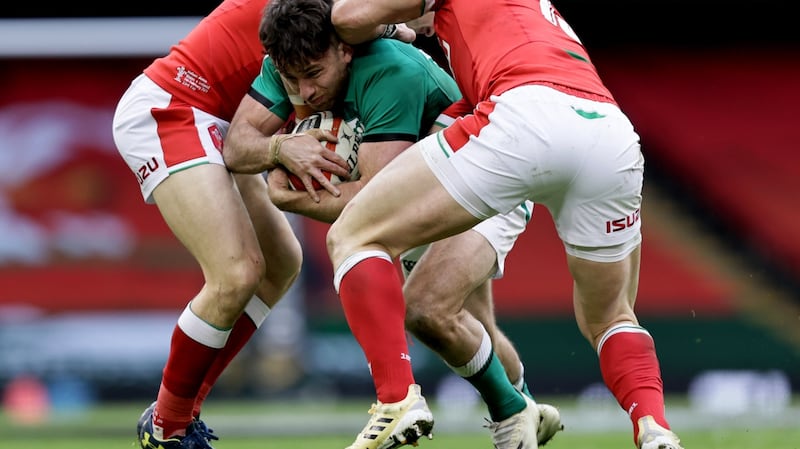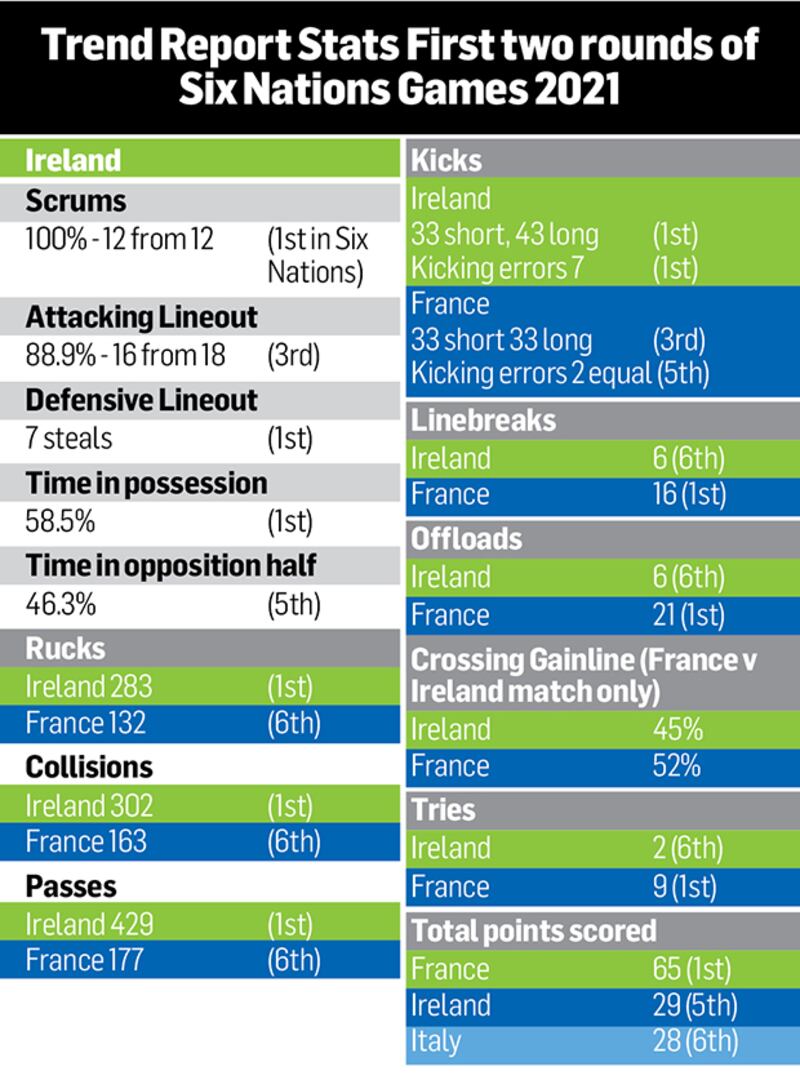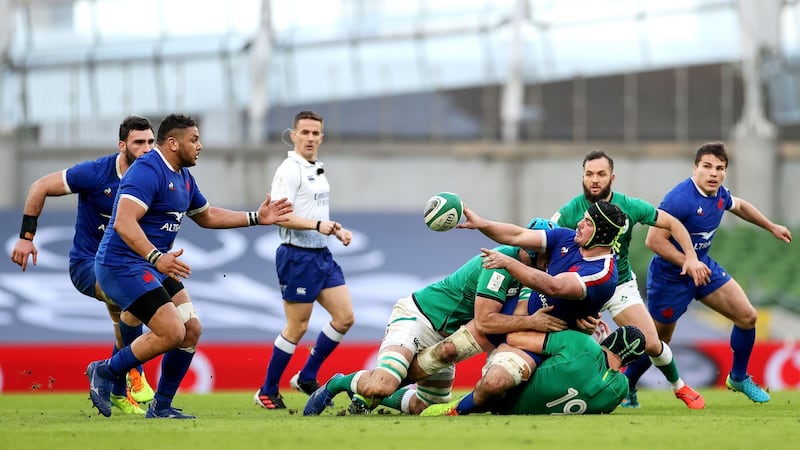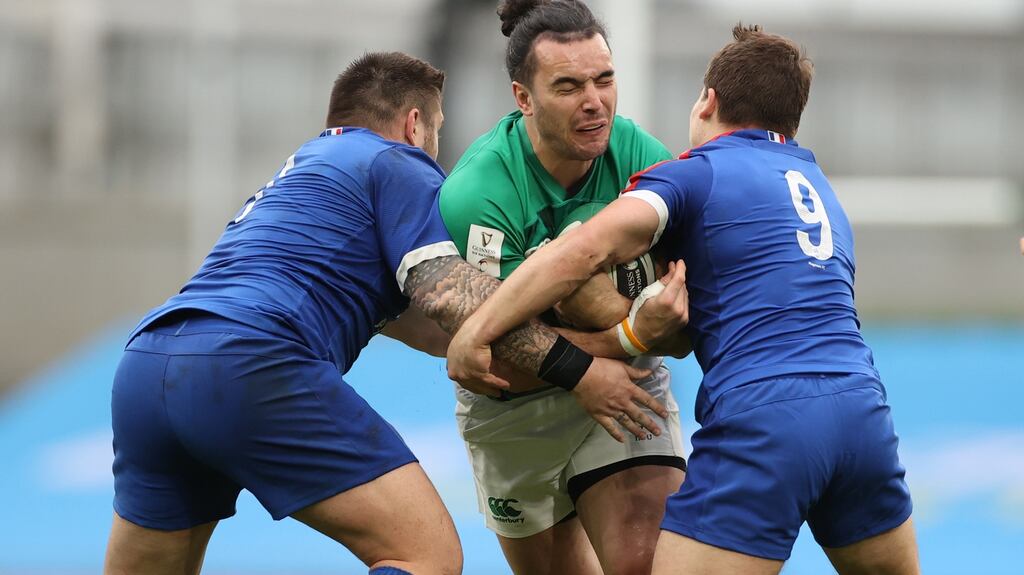In 2002 Thomas Kean, the former Republican governor of New Jersey, was appointed as Chairman of the National Commission of Inquiry into the September 11th, 2001 terrorist attacks on America. Kean is revered in American politics for his bi-partisan chairmanship.
Before each witness gave testimony, Kean provided the individual with wise counsel on how to provide their information to the commission.
“Just tell us the facts, with no adjectives.”
Last week the Six Nations organisation mirrored Governor Keans' leadership and issued an impressive in-depth statistical analysis, covering the opening two rounds of the championship entitled The Trend Report.
There were no adjectives in the 33 pages of information, but the facts on Ireland’s attack screamed from the pages. As we have all observed there were some good numbers.
Ireland's scrum is the only unit in the competition with a 100 per cent success rate – 12 win from 12 scrums. The entire pack and John Fogarty, Ireland's scrum coach, can be pleased with their progress.
The same can be said about the Irish lineout and forward's coach Paul O'Connell. The defensive lineout sits at the top of the Six Nations charts with an impressive seven steals from the two games.
The attacking lineout is also functioning adequately with 16 wins from 18 throws, producing a success rate of 88.9 per cent. However, it is not the powerhouse it once was with England enjoying a success rate of 90 per cent and Scotland at 92 per cent.
These numbers confirm the fact that Ireland are winning quality possession. That's the good news over with.

The principles of attack tell us that winning set play possession is only the foundation. That possession must be taken forward to cross the gainline. The attack must then be continued and supported, to apply pressure on the opposition to score points. This is not a theory, it is reality.
Second last
Ireland have held possession longer than any team. Averaging 40.3 minutes per game, enjoying 58.5 per cent of possession. Before we say that is a positive, we need to consider that with all of that possession Ireland have not dominated territory. Ireland have been in the opposition teams half only 46.3 per cent of the time, which puts them second last, only slightly above Italy at 43.5 per cent.
So despite having possession, Ireland have not dominated territory and we all know it’s hard to score from your own half.
Ireland top the ruck count with a massive 283 compared to the competition leaders France with only 132. Ireland also have the fastest ruck speed with 93.5 per cent of recycles below 2.76 seconds.
In possession Ireland have by far the most collisions, running into defenders a staggering 302 times in two games. Compare that to France, who have had only had 163 collisions.
Ireland also take another unwanted first place with by far the highest number of passes, an eye watering 429 compared to France, who only have 177 passes.
The myth that in Test match rugby the team that wins kicks the most has been torpedoed into the stands, as Ireland have kicked more than any other team with 76. They also have the highest kicking errors with seven.

So . . . Ireland are winning clean possession. The team are generating monumental quantities of fast rucks and passes. They are holding the ball longer than any other team in the championship and they are kicking the ball more than any other team.
Yet from these hundreds of collusions, rucks, kicks and passes, Ireland have not dominated territory and have scored only two tries, the lowest number in the championship. France have scored nine, using almost half of the number of passes, collisions carries and kicks. Wales have scored six with 120 per cent less carries than Ireland. Italy, who have played both England and France, have scored three tries.
The Trend Report shows that Ireland have only made eight line breaks, the lowest number, while France have made the most with 15.
The inability to penetrate has its foundation in the bare statistic that Ireland have crossed the gainline in attack only 45 per cent of the time. In other words, 55 per cent of Irish attacks have failed to cross the gainline.
After gaining possession, Ireland’s current attacking strategies are failing spectacularly to produce any ‘go forward’.
Battering rams
From their scrums, Ireland’s backline is not launching attacks with the imagination, deception or creativity required to manipulate the defenders, cross the gainline and seize attacking momentum. At every scrum the attacking team has a numerical advantage, yet Ireland are wasting their considerable backline talent by using the players as battering rams, smashing into immovable defenders and not targeting space.

With little go forward from set play our scrumhalves, who are wrongly showing no inclination to run and threaten the close in defenders, are throwing the burden of gaining momentum on to the shoulders of the Irish forwards. This is what has generated the staggering number of 302 collisions in two matches.
Like Governor Kean, I am offering a word of counsel to you, the Irish rugby public. Stop using the term ‘heads-up rugby’ to describe the Irish attack because it is a lie. Currently, the players catch the ball, get their heads up and all they are seeing is a solid line of rushing defenders who they then run into.
The lack of momentum from set play reduces the ability of forwards to put themselves into positions that either bend the defensive line or penetrate it with an offload. Across the championship any kind of offload is destroying the rushing defensive systems. This is because any attack that can get through the line, destroys the line. Ireland’s single creative try came against Wales when Tadgh Beirne broke Justin Tipuric’s tackle and offloaded to Josh van der Flier.
In two games France have executed 21 offloads, Italy 12, with Ireland the last of all the Six Nations teams with only six.
Sadly these statistics tell us all what I have been saying for some years: that this generation of Irish player has been methodically discouraged from even thinking about offloading. The skill of passing after contact has wrongly been obliterated from the Irish attack. Sadly that skill cannot be regained in a few weeks.
As my grandmother would say, “those birds have come home to roost.”
With the Irish attack unable to break opposition defensive lines from set play attacks or penetrate during phased attacks with offloading, in desperation, Ireland are going wide searching for overlaps. This is why they have produced the unimaginably high number of 429 passes, compared to the French 177. This tactic is pure folly. Attack has to earn the right to go around a defence by first going through it.
Easy targets
In attempting to create overlaps out wide, the Irish backs are running sideways and across field, destroying any overlaps that may have existed and making themselves easy targets for opposition defenders who are simply sliding and pushing them to the sidelines.
These statistics lead to the conclusion that the current attacking plan is failing in both its strategy and execution. The set play attacks are not empowering the players to cross the gainline and establish attacking momentum. On the following phases, Ireland are not breaking down the opposition defensive systems or attacking space behind the line with kicks or offloads and few overlaps have been executed.
That conclusion may be disappointing but it should not be unexpected. The numbers don’t lie.
Ireland should win in Rome against the worst defence in the competition and an Italian team who haven’t won a game in years. But Ireland are wounded and there is blood in the water. The Scottish and English sharks are circling. The chaos of the deficiencies of the Irish attacking plan will not be papered over in Rome.
To create order from this chaos is the role of the coaches. That requires new strategies and far better on-field execution.
The clock is ticking.
Trend Report Stats - First two rounds of Six Nations Games 2021
Ireland
Scrums
100% - 12 from 12 (1st in Six Nations)
Attacking Lineout
88.9% - 16 from 18 (3rd)
Defensive Lineout
7 steals (1st)
Time in possession
58.5% (1st)
Time in opposition half
46.3% (5th)
Rucks
Ireland 283 (1st)
France 132 (6th)
Collisions
Ireland 302 (1st)
France 163 (6th)
Passes
Ireland 429 (1st)
France 177 (6th)
Kicks
Ireland
33 short, 43 long (1st)
Kicking errors 7 (1st)
France
33 short 33 long (3rd)
Kicking errors 2 equal (5th)
Linebreaks
Ireland 6 (6th)
France 16 (1st)
Offloads
Ireland 6 (6th)
France 21 (1st)
Crossing Gainline (France v Ireland match only)
Ireland 45%
France 52%
Tries
Ireland 2 (6th)
France 9 (1st)
Total points scored
France 65 (1st)
Ireland 29 (5th)
Italy 28 (6th)












